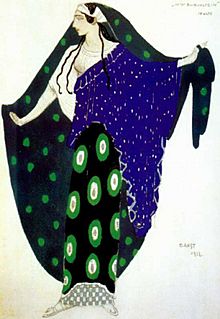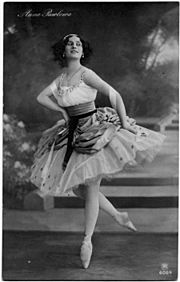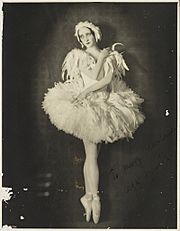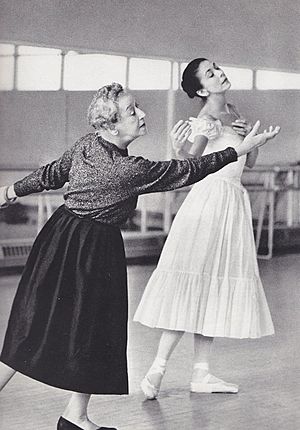Ballet facts for kids

Ballet is a type of dance. It is only done by dancers who have had special training. The dancers are employed by a dance company, and they perform in theatres. The first reference to ballet is found in a work of Domenico da Piacenza, who lived in the early 14th century.
Ballet involves the creation of the dance itself, often a type of imaginary story.The story is told with the help of dance and mime. Ballet is a form of expression. It presents a story in a new form to the audience. The creation of dance is called choreography. The choreography is learnt by the dancers under the supervision of a trainer, called a ballet master or mistress. Ballet is always performed to music, and in many cases the music was specially composed for a particular ballet. Ballet is a major part of theatre, and a popular example is The Nutcracker.
Contents
History
Early stages
Ballet grew out of Renaissance spectacles which, rather like big pop music events today, used every type of performance art. These Italian ballets were further developed in France. Le Ballet Comique de la Reine (The Queen's Ballet Comedy) was performed in Paris in 1581. It was staged by Balthazar de Beaujoyeux, a violinist and dancing master at the court of Catherine de Medici. It was danced by amateurs in a hall. The royal family were watching at one end and the others in galleries on three sides. Poetry and songs came with the dances.
The basis of classical ballet was formed in the Court of Louis XIV in France, in the 17th century.p40 Even his title (the 'Sun King') came from a role he danced in a ballet. Louis founded the first ballet company, the Ballet de l'Opera de Paris. Many of the ballets presented at his court were created by the composer Jean-Baptiste Lully and the choreographer Pierre Beauchamp. Also during this time, the playwright Molière invented the comedie-ballet.
Modern technique begins
In the early 19th century ballet technique was codified (sorted out and written down) by Carlo Blasis (1797–1878) of Naples. His dance classes, four hours long, were famous for being the toughest training there was at that time. 'Romantic ballet' flourished in France in the first half of the 19th century.
Ballet with a more athletic style was developed in Imperial Russia of the late 19th century. This company performed in the Mariinsky Theatre at St. Petersburg. The three famous Tchaikovsky ballets, Swan Lake, The Sleeping Beauty, and The Nutcracker, date from that time. The next stage was the Diaghilev ballet. Diageilev was a great impresario (showman). In 1909 he founded Les Ballets Russes de Sergei Diaghilev, considered by many to be the greatest ballet company of all time.
- "Its success was so extraordinary, its ballets so revolutionary, and its artists so electrifying that its appearance in Paris before the First World War sparked an international ballet boom".p47
His dancers included the legendary Nijinsky and the Imperial primaballerina Karsavina; also Pavlova, Danilova and Spessivtseva. His choreographers included Fokine, Massine and Balanchine; his composers included Stravinsky, Prokofiev, Ravel and Debussy; his set designers included Picasso, Cezanne, Matisse, Utrillo, Bakst and Braque; and the ballets created changed the course of ballet history.
Later in the 20th century, permanent ballet companies were set up in English-speaking countries. The Royal Ballet in London was started, and in New York a company called the Ballet Russe de Monte Carlo was founded (1938–1962).
Technique
Technique is the physical ability to perform whatever steps a dance may need. Specific methods for refining technique are named after the ballet master or mistress who started them, such as the Vaganova method after Agrippina Vaganova, the Balanchine method after George Balanchine, and the Cecchetti method after Enrico Cecchetti.
Costumes
Ballet costumes play an important role in the ballet world. They are often the only survival of a production, representing a living imaginary picture of the scene.
Renaissance and Baroque
The roots of ballet go back to the Renaissance time in France and Italy when court wear was the beginning of ballet costumes. Ballet costumes have been around since the early fifteenth century. Cotton and silk were mixed with flax woven into semitransparent gauze to create exquisite ballet costumes.
Seventeenth Century
During the seventeenth century, different types of fabrics and designs were used towards ballet costumes to make them much more spectacular and eye catching. Court dress still remained for women during this century. Silks, satins and fabrics embroidered with real gold and precious stones increased the level of spectacular decoration associated with ballet costumes.Women's costumes also consisted of heavy garments and knee-long skirts which made it difficult for them to create much movement and gesture.
Eighteenth Century
During the eighteenth century, stage costumes were still very similar to court wear but progressed over time, mostly due to the French dancer and ballet-master Jean-Georges Noverre (1727 - 1810) whose proposals to modernize ballet are contained in his revolutionary Lettres sur la danse et les ballets (1760). Noverre proclaimed in his text that ballet should unfold through dramatic movement and the movement should express the relationship between the characters. Prior to Noverre, Ballet's were large spectacles that focused mainly on elaborate costumes and scenery and not on the physical and emotional expression of the dancers.
European ballet was centered in the Paris Opera. During this era, skirts were raised a few inches off the ground compared to the Renaissance period and the seventeenth century. Overtime, costumes progressed as more designs and colors were used on ballet costumes. Flowers, flounces, ribbons, and lace emphasized this opulent feminine style, as soft pastel tones in citron, peach, pink and pistachio dominated the color range of stage costumes.
Nineteenth Century
During the early nineteenth century, close-fiting body costumes, floral crowns, corsages and jewels were used during this time. Ideals of Romanticism were reflected in female stage. Costumes became much tighter as corsets started to come into use to show off the curves on a ballerina. Jewels and bedazzled costumes became much more popular.
Twentieth Century
During the twentieth century, ballet costumes transitioned back to the influence of Russian ballet. Ballerina skirts became knee-length tutus later on in order to show off pointe work and mainly the technique of ballet dancers. During this era, costumes focused on the importance of a ballet dancers work and dance practice. Colors used on stage costumes also became much more vibrant. Designers used colors such as red, orange, yellow, etc. to create visual expression when ballet dancers perform on stage.
Some famous ballet dancers
- Margot Fonteyn
- Tamara Karsavina
- Mikhail Baryshnikov
- Anna Pavlova
- Rudolf Nureyev
- George Balanchine
- Vaslav Nijinsky
- Misty Copeland
- Natalia Makarova
- Diana Vishneva
- Carlos Acosta
Related pages
Images for kids
-
Classical bell tutus in The Ballet Class by Degas, 1874
-
Louis XIV as Apollo in the Ballet Royal de la Nuit (1653)
-
Marie Sallé, classical ballet dancer
-
Carlotta Grisi, the original Giselle, 1841, wearing the romantic tutu
-
Alexandra Danilova and Serge Lifar, Apollon Musagète, 1928
-
Suzanne Farrell and George Balanchine dancing in a segment of "Don Quixote" at New York State Theater
See also
 In Spanish: Ballet para niños
In Spanish: Ballet para niños





















